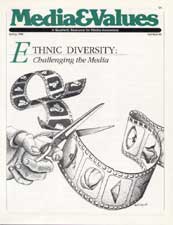FAMILY: 'Tossed Salad' Culture Honors Diversity
|
This article originally appeared in Issue# 43
|
During the 1960s, I moved from Georgia to Maryland and then to Connecticut. All of a sudden I was a Southern, white, Protestant female living first in a Baltimore ghetto and then in an Irish/Italian, Catholic, blue-collar neighborhood. I had become a minority, and while I learned that many of my fears were unfounded, I felt isolated and invisible.
This experience taught me that fears grow from focusing on differences rather than similarities. Though the melting pot image suggests inclusivity, it can homogenize away individuality. I prefer to think of the U.S. as a tossed salad, with room for diverse and distinct parts in a common whole.
How well do our media reflect the tossed salad, instead of insisting on the myth of the melting pot? Certainly they've made progress. But the mere presence of different ethnic groups on television does not guarantee that dignity or importance will be part of the message. Nor does it insure that we see the diversity and varied character of any ethnic group.
As the mother of a large family, I find this troubling. Research shows that television and film images of ethnic persons are accepted as representative of their particular groups. Furthermore, many viewers have no experience, positive or negative, with anyone different from themselves. Thus, they are very open to media reinforcement of their previous stereotypes.
What can we do about this? We can watch programs that treat their characters as human beings and tune out those that don't. We can also write complimentary or critical letters to networks and sponsors.
But as members of families, we can begin by raising our ethnic consciousness, starting with our backgrounds. Consider learning about your own ethnic heritage and telling its stories to your family. Even those with ties to no particular ethnic group come from a family, a region, a religion whose ways can be learned and cherished.
In addition to library and video store research, grandparents or other elderly relatives may be a resource for families seeking to preserve their heritages.
Consider video or audio taping their memories or storytelling. If they are known for a special craft or skill (making holiday cookies, woodcarving), a video will provide memories to cherish and honor a loved tradition. Families without video cameras can work with photographs, clippings and scrapbooks.
Since the ideal model of family is one where each person matters, the family unit can provide guidance for being open and accepting of other kinds of people as well. As families blend and extend, we can choose to grow into a broader, more inclusive experience of living. Championing diversity is a complex task, yet vital in maintaining a culture's health. Let us begin at home.



